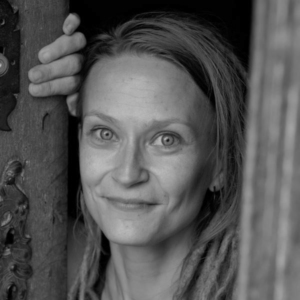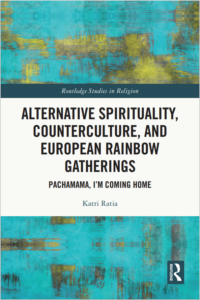Welcome to 7 Questions, our series where we highlight exciting scholars in the field of religion and get to know the person behind the book. For this article, we interviewed Katri Ratia, whose book Alternative Spirituality, Counterculture, and European Rainbow Gatherings: Pachamama, I’m Coming Home was published with Routledge Press this March.
Get to Know Katri

Katri Ratia is a Finnish researcher with a PhD in religious science, teaching and researching at the University of Fribourg in Switzerland. Her interests are with vernacular and alternative forms of religion, ritual studies and especially creativity in ritual, material religion, folklore studies, and mythology. When she is not reading, writing, or sciencing, she has been seen collecting interesting rocks, doing weird art and questionable crafts, poking fun at humanity in general, and swearing that the absurd amount of plants in the house is not pathological.
Katri Answers Our 7 Questions
Question 1: What sparked the idea to write this book?
This book came out of my doctoral thesis. I wrote heaps more for the dissertation, and my instructor felt that parts of the text could be great for publication, and surprisingly, the publisher agreed. So, I edited the beast down. But as for what sparked the idea to pick this topic for my thesis in the first place, I wanted to write about something interesting that I felt was not studied enough, and what I was familiar with: the countercultural hippie utopia known as Rainbow Gatherings in Europe.
Question 2: What role does the sacred play in relation to your work broadly? Where do you see the sacred or sacred things in this book specifically?
Regarding my work in general, I am interested in alternative and vernacular expressions of the sacred, their contexts and contingencies, and their relations to other fundamental cultural realms. I am fascinated by the fact that the sacred and relating to it can take forms which address complex political, environmental, social, and economic concerns. Religion and ritual, and the way that they conceptualize and frame the sacred, can be very creative, expressive, and purposeful in their contexts.
In the Rainbow, sacred has two kinds of manifestations: the subjective beliefs and practices of the participants, whatever they may be, and the collective Gathering ethos with its focuses in sacralised nature and human interconnectedness. The Gatherings claim a total religious freedom and to celebrate religious plurality, and participants are invited to express, share and cultivate their spiritual views as they please. Most Gatherings in Europe include rituals, workshops, and individual religious expressions relating to a motley spectrum of religious traditions and ideas. In addition, there is a collective ritual tradition structuring the daily life in the Gathering events. Although the collective Rainbow tradition is not explicitly religious (and many participants abhor the word), it does involve a hefty dose of rituality and alternative forms of ‘spirituality’, and I found a way to analyse the religious aspects of it without forcing it into the ill-fitting moulds of institutional, doctrinal, or belief-centred religion. Rainbow’s collective sacred is definitely in nature, ranging from allegorical aspects of environmental awareness to contemporary Paganisms and ‘Dark Green Religion’ in its many other forms.
Question 3: If you were to describe the book to someone who is unfamiliar with religious and academic jargon, how would you summarize it?
This book presents the roots and origin of the Rainbow Family, one of the most long-lived countercultural movements in the Western world. This book is the first academic work detailing Rainbow Family’s international migrations, its spread and activities in Europe, and describing the European Gathering events and their culture carefully. The book analyses the Gatherings in relation with Western counterculture and alternative-holistic spirituality, and discusses the implicit religious aspects of the Gatherings based not on beliefs, but on practices such as collective rituals and instances of symbolic and concrete exchange.
Question 4: Who were models or inspirations for you as you wrote this book?
I was inspired by many brilliant writers and academics researching contemporary Paganisms and alternative forms of spirituality, but especially those who have worked with events and immersive ethnography such as Sarah Pike, Graham St John, Anna Fedele, Marion Bowman, Sabina Magliocco, Graham Harvey, my instructor François Gauthier and the OG Rainbow scholar Michael Niman, just to name a few.
Question 5: What was the most difficult thing about writing the book? Did you encounter any unexpected problems or challenges?
Doing the research had its own challenges for sure, from fieldwork in the Gatherings to the fact that there are not so many established ways to
model non-institutional religious traditions and alternative forms of religiosity in an adequate way. I had to reach outside of the box and just trust that I can make it work, and that I can justify my theoretical and analytical choices in the defence of my thesis. It was also difficult to skim back the dissertation to fit the limits set by my publisher, and I do recommend anyone who is interested in the actual science behind this book to contact me for the original version. Some unexpected challenges came up with the prolonged publication process as well, mostly due to the Plague Years we just went through, and all the obstacles and confusion they brought.

Question 6: What has surprised you the most about the book, either in its writing or reception?
As the book just came out, I still await to hear how the book will finally be received, both within academia and among my informants, and I’m sure there will be surprising responses in both sides. In academia, alternative-holistic ‘spiritualities’ and crafted rituals are still sometimes regarded as something insignificant, superficial or less-than-real, and among the proponents of any religious tradition, academic analyses can feel depreciative, overcritical, or condescending. But during my fieldwork and historical research, I was surprised many times by the absurdly harsh attitudes that state officials have shown towards Rainbow Gatherings, especially in Europe where the Gatherers are basically a bunch of nonviolent hippies.
Question 7: With this book done, what’s up next for you?
The academic scraping-along of funding applications, teaching assignments, and Post-Doc aspirations. I want to study creative rituality in action, both in everyday life and in community settings. Some very interesting ritual studies projects are also in the works, and I’m excited about the chance to dedicate more time to them! But first, I’m going to take the occasion to celebrate my book by dancing around the Main Fire as soon as I get the chance. Love you Family!
You can order Alternative Spirituality, Counterculture, and European Rainbow Gatherings here.
